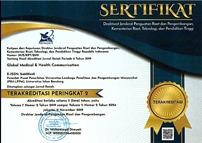Evaluating Risk Factors for Early-onset Neonatal Sepsis
Abstract
Keywords
Full Text:
PDFReferences
Gomella TL, Eyal FG, Bany-Mohammed F, editors. Gomella's neonatology: Management, procedures, on-call problems, diseases, and drugs. 8th edition. New York: McGraw-Hill Education; 2020.
Kuzniewicz MW, Mukhopadhyay S, Li S, Walsh EM, Puopolo KM. Time to positivity of neonatal blood cultures for early-onset sepsis. Pediatr Infect Dis J. 2020;39(7):634–40.
Kucova P, Kantor L, Fiserova K, Lasak J, Röderova M, Kolar M. Bacterial pathogens and evaluation of a cut-off for defining early and late neonatal infection. Antibiotics (Basel). 2021;10(3):278.
Poupolo KM. Bacterial and fungal infection. In: Eichenwald EC, Hansen AR, Martin CR, Stark AR, Jain N, editors. Cloherty and Stark’s manual of neonatal care. South Asian edition. New Delhi: Wolters Kluwer; 2021. p. 743–76.
Shane AL, Sánchez PJ, Stoll BJ. Neonatal sepsis. Lancet. 2017;390(10104):1770–80.
Li J, Shen L, Qian K. Global, regional, and national incidence and mortality of neonatal sepsis and other neonatal infections, 1990–2019. Front Public Health. 2023;11:1139832.
Stoll BJ. Neonatal infections: a global perspective. In: Remington JS, Klein JO, editors. Infectious diseases of the fetus and newborn infant. 5th edition. Philadelphia: Elsevier Saunders; 2001. p. 141.
Juniatiningsih A, Aminullah A, Firmansyah A. Profil mikroorganisme penyebab sepsis neonatorum di Departemen Ilmu Kesehatan Anak Rumah Sakit Cipto Mangunkusumo Jakarta. Sari Pediatri. 2008;10(1):60–5.
Putra PJ. Insiden dan faktor-faktor yang berhubungan dengan sepsis neonatus di RSUP Sanglah Denpasar. Sari Pediatri. 2012;14(3):205–10.
Narasimha A, Harendra Kumar ML. Significance of hematological scoring system (HSS) in early diagnosis of neonatal sepsis. Indian J Hematol Blood Transfus. 2011;27(1):14–7.
Yadav P, Kumar Yadav S. Progress in diagnosis and treatment of neonatal sepsis: a review article. J Nepal Med Assoc. 2022;60(247):318–24.
Fitriana L, Ramadanti A, Indrayady I. Scoring model to predict early-onset bacterial sepsis at Dr. Mohammad Hoesin Hospital, Palembang. Paediatr Indones. 2023;63(1):29–36.
Lusyati S, Sauer PJJ. Sepsis neonatal di NICU RSAB Harapan Kita Jakarta. Sari Pediatri. 2007;9(3):173–7.
Suwarna NO, Yuniati T, Cahyadi AI, Achmad TH, Agustian D. Faktor risiko kejadian sepsis neonatorum awitan dini di RSUP Dr. Hasan Sadikin Bandung. Sari Pediatri. 2022;24(2):99–105.
Sianturi P, Hasibuan BS, Lubis BM, Azlin E, Tjipta GD. Profil sepsis neonatus di Unit Perawatan Neonatus RSUP H Adam Malik Medan tahun 2008–2010. Sari Pediatri. 2012;14(2):67–72.
Giannoni E, Agyeman PKA, Stocker M, Posfay-Barbe KM, Heininger U, Spycher BD, et al.; Swiss Pediatric Sepsis Study. Neonatal sepsis of early onset, and hospital-acquired and community-acquired late onset: a prospective population-based cohort study. J Pediatr. 2018;201:106–114.e4.
Lim WH, Lien R, Huang YC, Chiang MC, Fu RH, Chu SM, et al. Prevalence and pathogen distribution of neonatal sepsis among very-low-birth-weight infants. Pediatr Neonatol. 2012;53(4):228–34.
Hafidh Y, Hidayah D, Sunyataningkamto S. Factors affecting mortality of neonatal sepsis in Moewardi Hospital, Surakarta. Paediatr Indones. 2007;47(2):74–7.
Masanja PP, Kibusi SM, Mkhoi ML. Predictors of early onset neonatal sepsis among neonates in Dodoma, Tanzania: a case control study. J Trop Pediatr. 2020;66(3):257–66.
Utomo MT. Risk factors of neonatal sepsis: a preliminary study in Dr. Soetomo Hospital. IJTID. 2010;1(1):23–6.
Joseph CJ, Lian WB, Yeo CL. Nosocomial infections (late onset sepsis) in the neonatal intensive care unit (NICU). Proc Singap Healthc. 2012;21(4):238–44.
Shifera N, Dejenie F, Mesafint G, Yosef T. Risk factors for neonatal sepsis among neonates in the neonatal intensive care unit at Hawassa University Comprehensive Specialized Hospital and Adare General Hospital in Hawassa City, Ethiopia. Front Pediatr. 2023;11:1092671.
Wilar R, Kumalasari E, Suryanto DY, Gunawan S. Faktor risiko sepsis awitan dini. Sari Pediatri. 2010;12(4):265–9.
Hafidz A, Yuniati T, Solek P. Neopterin serum as early predictor of poor outcome in neonatal sepsis. GMHC. 2017;5(3):241–6.
DOI: https://doi.org/10.29313/gmhc.v12i2.13940
pISSN 2301-9123 | eISSN 2460-5441
Visitor since 19 October 2016:
Global Medical and Health Communication is licensed under a Creative Commons Attribution-NonCommercial-ShareAlike 4.0 International License.































.png)
_(1).png)
_(1).jpg)
